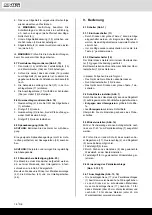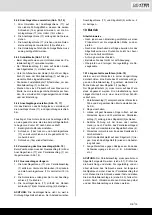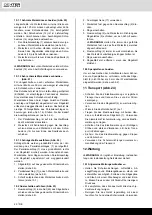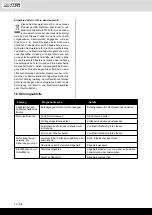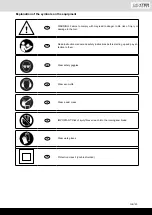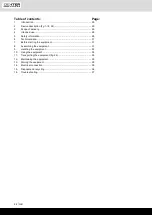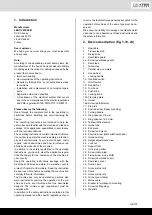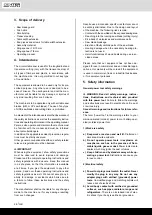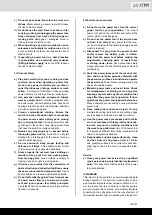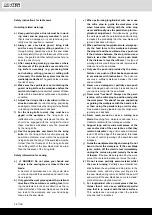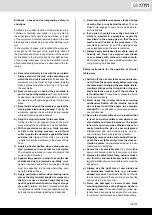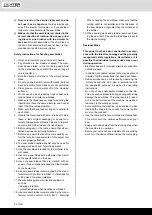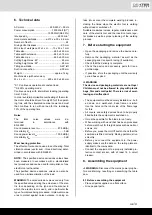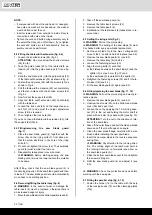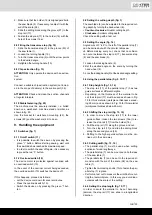
32 | GB
2. Take off the saw blade guard (4).
3. Remove the table insert screws (32).
4. Remove the table insert (6).
5. Installation of the table insert (6) takes place in re-
verse order.
8.5 Setting the riving knife (fig. 9)
m
WARNING:
Pull out the mains plug.
m
WARNING:
The setting of the saw blade (5) must
be checked after every saw blade replacement.
1. Set the saw blade (5) to the max. cutting depth,
move to the 0° position and lock in place (see 9.2).
2. Remove the saw blade guard (4) (see 8.3).
3. Remove the table inlay (6) (see 8.4).
4. Loosen the fastening screws (33)
5. Align the riving knife (3) such that
a) the distance between the saw blade (5) and the
splitter (3) is max. 5 mm (fig. 10) and
b) the saw blade (5) is parallel to the splitter (3).
6.
Retighten the fastening screws (33) and fit the ta
-
ble insert (6) (see 8.4).
7. Fit the saw blade guard (4) again (see 8.3).
8.6 Fitting/replacing the saw blade (fig. 11, 12)
m
WARNING:
Pull out the mains plug and wear pro-
tective gloves.
1. Remove the saw blade guard (4) (see 8.3).
2. Unscrew the screws (34) on the bottom saw blade
cover (35) and open it out.
3. Loosen the nut by applying the 19 mm ring span-
ner (21) to the nut and holding the motor shaft in
place with an 8 mm ring spanner (20) (see fig. 12).
ATTENTION:
Turn the nut in the direction of rota-
tion of the saw blade.
4.
Take off the outer flange and pull the old saw blade
down and off the inner flange at an angle.
5.
Clean the saw blade flange carefully with a wire
brush before installing the new saw blade.
6. Insert the new saw blade in the reverse sequence
and tighten.
m
WARNING:
Pay attention to the running direc-
tion. The cutting angle of the teeth must point in
the running direction, i.e. forwards (see arrow on
the saw blade guard (4)).
7. Close the bottom saw blade cover (35) and tighten
the screws (34) again.
8.
Refit the saw blade guard (4) and adjust it (see
8.3).
m
WARNING:
Check the protective devices before
working with the saw again.
8.7 Fitting the parallel stop (fig, 2, 15)
1. Fasten the holder (16) to the table with the help
of the locking knobs (15) and the clamping plates
(15a).
NOTE:
• If compounds with a bolt (round head / or hexagon),
hex nuts and washers are backed up, the washer
must be fitted under the nut.
• Insert screws each from outside to inside. Secure
connections with nuts on the inside.
• Tighten the nuts and bolts during assembly only to
the extent that they can not fall down. If you tighten
the nuts and bolts prior to final assembly, final as
-
sembly can not be performed.
8.2 Fitting the table width extension (fig. 4-6)
1.
Loosen the knurled screws (26) (fig. 5).
ATTENTION:
Do not unscrew the knurled screws
(26) too far.
2. Feed the guide tubes (23) of the table width ex-
tension (22) into the guide bushings (27) (see fig.
4/5).
3. Slide the end pieces (24) into the guide tubes (23)
of the table width extension (22) as shown in fig. 6.
4. Fasten the end pieces (24) with the screws (25) as
shown in Fig. 6.
5. Pull the table width extension (22) out completely
and fasten in place with the knurled screws (26)
(Fig. 5).
6. Now fold out the support feet (30).
7. Align the table width extension (22) horizontally
with the table saw.
8. Loosen the lock nuts (29) on the respective sup-
port foot (30) and adjust the height adjustment
screw (28) as required.
9. Then retighten the lock nuts (29).
If you do not need the table width extension (22), fold
the support feet (30) in.
8.3
Fitting/removing the saw blade guard
(fig. 7)
1. Place the saw blade guard (4) together with the
screw (4a) on the riving knife (3) from above, so
that the screw sits firmly in the hole of the riving
knife (31).
2. Do not over-tighten the screw (4a). The saw blade
guard (4) must remain free to move.
3. Disassembly takes place in reverse order.
m
WARNING:
Before starting sawing, the saw
blade guard (4) must be lowered onto the material
to be sawn.
After fitting, check that the saw blade guard (4) is
functioning properly. Lift the saw blade guard and then
release it. The saw blade guard should automatically
move back to its starting position.
8.4 Removing/fitting the table inlay (fig. 8)
m
WARNING:
In the event of wear or damage the
table insert (6) must be replaced; otherwise there is
an increased danger of injury.
1. Move the saw blade into the bottom position (see 9.2).
Summary of Contents for 3901309953
Page 2: ...2 ...
Page 4: ...4 10 6 6 7 9 8 8 14 11 4a 12 14 13 24 32 34 20 21 33 25 23 4 35 20 36 3 6 3 31 max 5mm ...
Page 5: ...5 16 18 14 19 20 15 17 21 45 8 17 16a 37 9 16 17 16 17 18 19 40 39 16a 38 38 16a 17 ...
Page 6: ...6 22 24 23 41 25 42 43 43 42 44 44 ...
Page 70: ...70 ...
Page 72: ...72 ...
Page 76: ...LEROY MERLIN RUE Chanzy Lezennes 59712 LILLE Cedex 9 France ...

